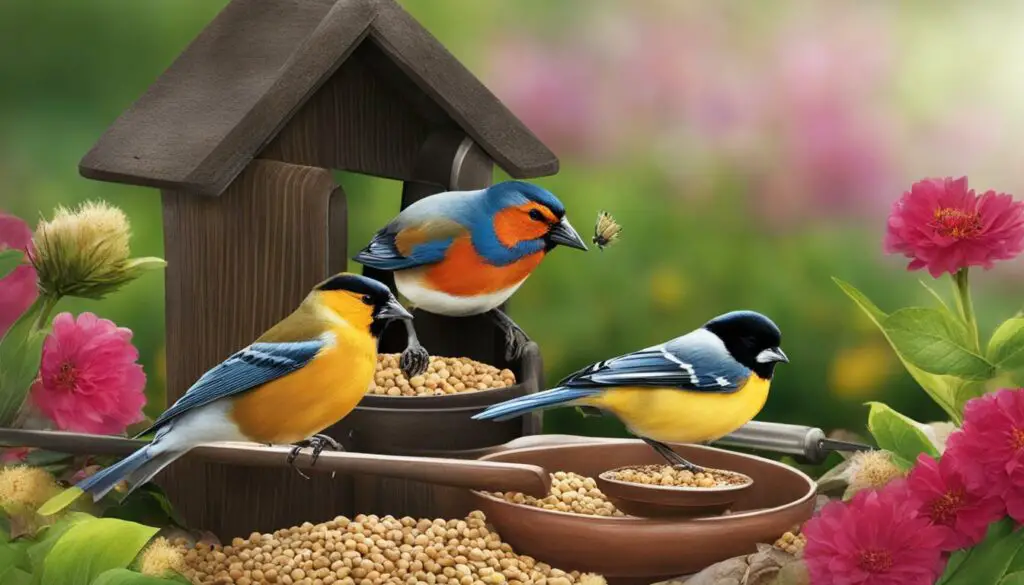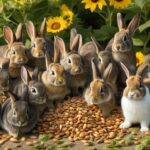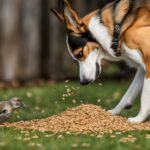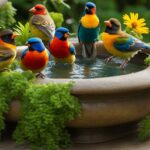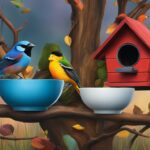Welcome to the world of bird seed feeding! If you’re an avid bird lover looking to attract a diverse range of feathered friends to your backyard, then you’ve come to the right place. In this article, I’ll share with you essential guidelines for bird seed feeding, including the types of bird seed, their preferences, and how to create a welcoming environment for birds to thrive.
Key Takeaways:
- Offer a variety of seeds in separate feeders to attract a greater variety of birds.
- Choose the right seed for the birds you want to attract.
- Popular bird seed types include black-oil sunflower seed, Nyjer (thistle) seeds, peanuts, and blends.
- Provide fresh water sources and create a bird-friendly yard with native plants.
- Maintain and clean your feeders regularly to ensure a hygienic environment for birds.
Best bird seed for attracting backyard birds
When it comes to attracting a variety of beautiful birds to your backyard, choosing the right bird seed is crucial. Different birds have different preferences, so offering a diverse range of seeds will help attract a greater variety of species. Here are some bird seed recommendations to help you create an enticing buffet for your feathered friends:
- Black-oil sunflower seed: This type of seed is a favorite among many small feeder birds, especially in northern latitudes. It appeals to a wide range of birds, including jays, woodpeckers, finches, and cardinals.
- Millet: Ground-feeding birds like sparrows and juncos favor millet. Adding millet to your birdseed mix will attract these lovely visitors to your backyard.
- Cracked corn: Birds that feed on the ground, such as jays and doves, are often attracted to cracked corn. Including it in your birdseed blend will entice these species to visit your feeders.
- Nyjer (thistle) seed: Goldfinches, finches, and redpolls are particularly fond of Nyjer seed. Providing this type of seed will attract these colorful songbirds to your backyard.
Remember to offer a mix of different seeds to cater to the preferences of various bird species. This will not only increase the number of birds visiting your feeders but also add vibrant colors and delightful melodies to your outdoor space.

Table: Common backyard birds and their preferred seeds
| Bird Species | Preferred Seeds |
|---|---|
| Cardinals | Black-oil sunflower seed, safflower seed |
| Finches | Black-oil sunflower seed, Nyjer seed |
| Jays | Black-oil sunflower seed, cracked corn |
| Sparrows | Millet, cracked corn |
| Woodpeckers | Black-oil sunflower seed, suet |
By offering the best bird seed options for backyard birds, you can create a welcoming environment and enjoy the beauty and charm of these delightful creatures.
Providing Suet and Bird Puddings
When it comes to bird feeding, offering suet and bird puddings can be a great addition to your backyard bird buffet. Suet, a mixture of beef fat and seed, is a favorite among many species, including woodpeckers, wrens, chickadees, nuthatches, and titmice. To offer suet to your feathered friends, you can place it in special feeders or even repurpose net onion bags.
It is essential to hang suet feeders at least five feet above the ground to keep them out of the reach of animals. Regular cleaning of suet feeders is also crucial to maintain hygiene, especially in warmer weather when “no melt” suet cakes should be used to prevent mess and spoilage. When it comes to bird seed storage, it’s important to keep seeds in a cool, dry place to prevent spoilage and infestation.
Adding variety to your bird feeding routine with suet and bird puddings not only provides additional food options for your feathered visitors but also adds excitement to their dining experience. By practicing proper feeder maintenance and seed storage, you can ensure a healthy and enjoyable environment for both you and your avian friends.
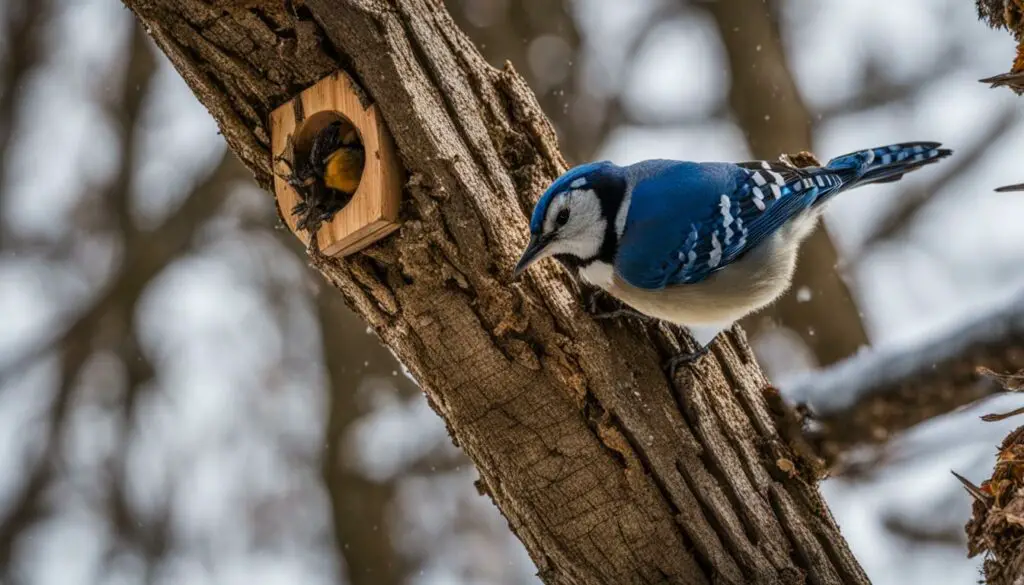
Bird Feeding Tips and Bird Seed Dos and Don’ts
Feeding birds can be a rewarding experience, but it’s important to follow some tips and guidelines to ensure the birds’ well-being and enjoyment. Here are some bird feeding tips to help you attract a wide variety of beautiful birds to your backyard:
- Choose the right bird seed: Different bird species have different preferences when it comes to seed. By offering a variety of seeds, you can attract a diverse range of birds. Popular seed types include black-oil sunflower seeds, Nyjer (thistle) seeds, and millet. Avoid using seed blends with fillers like corn, oats, or wheat, as these can attract unwanted pests.
- Provide fresh water: Birds need access to clean water for drinking and bathing. Consider placing a bird bath or shallow dish of water in your yard. Make sure to change the water regularly to prevent the spread of diseases.
- Keep feeders clean: Regularly clean your bird feeders to prevent the buildup of mold, bacteria, and other contaminants. Use warm water and mild soap to wash the feeders at least once a month. Rinse thoroughly and allow them to dry completely before refilling.
- Place feeders in safe locations: Position feeders near trees or shrubs that provide cover for birds to hide from predators. Avoid placing feeders too close to windows, as birds may collide with the glass. If you have issues with squirrels or other unwanted animals, use squirrel-proof feeders or baffles to deter them.
Following these bird feeding tips will not only attract a wide variety of birds to your backyard but also ensure their health and safety. By providing the right seed, fresh water, clean feeders, and safe feeding locations, you can create a bird-friendly environment and enjoy the beauty of these feathered visitors.
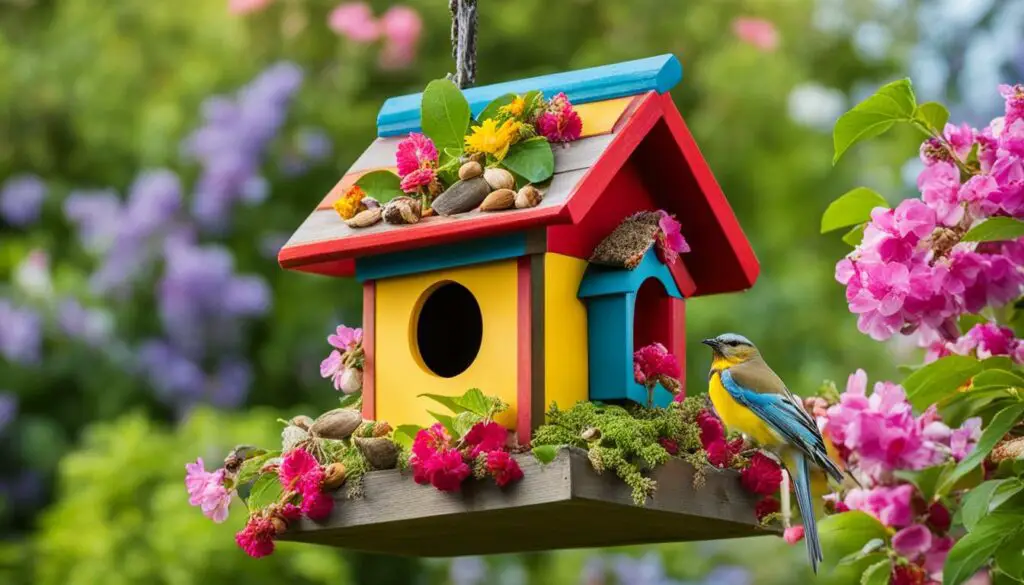
Table: Popular Bird Seeds and Preferred Bird Species
| Bird Seed | Preferred Bird Species |
|---|---|
| Black-oil sunflower seeds | Jays, finches, woodpeckers, cardinals |
| Nyjer (thistle) seeds | Goldfinches, finches, redpolls |
| Millet | Sparrows, juncos |
| Safflower seeds | Cardinals, grosbeaks, sparrows |
By offering a mix of these popular bird seeds, you can attract a diverse range of bird species to your feeders. Remember to regularly clean and refill your feeders, provide fresh water, and create a safe environment for birds to enjoy their meals.
Bird Feeding Basics
Feeding birds is a wonderful way to connect with nature and support the well-being of our feathered friends. By providing a reliable food source, you can attract a diverse array of bird species to your backyard and enjoy the beauty and excitement of birdwatching. Here are some essential guidelines for feeding birds:
1. Choose the Right Bird Seed
When selecting bird seed, it’s important to consider the preferences of different bird species. Popular options include black-oil sunflower seed, Nyjer (thistle) seed, peanuts, and blends containing sunflower seeds, millet, and cracked corn. Offering a variety of seeds in separate feeders will attract a greater variety of birds. This allows you to cater to the specific needs and preferences of different species, ensuring that you attract a diverse range of feathered visitors.
2. Provide Fresh Water
In addition to food, it’s crucial to provide birds with a fresh water source. A bird bath or shallow dish filled with clean water can attract birds for drinking and bathing. Moving water, such as a birdbath with a fountain or dripper, is particularly appealing to birds. Make sure to clean and refill the water source regularly to keep it fresh and prevent the spread of diseases.
3. Create a Safe Environment
When setting up your bird feeders, consider the safety of the birds. Place feeders at least 10 feet away from windows to prevent bird collisions. Avoid areas accessible to predators like outdoor cats. Regularly clean the feeders to remove moldy or clumped seed, as these can be harmful to birds. By creating a safe environment, you can ensure the well-being and enjoyment of the birds that visit your backyard.
Feeding birds is a rewarding and satisfying activity. By following these bird feeding guidelines, you can attract a diverse range of bird species and contribute to their well-being. So grab your binoculars, set up some feeders, and get ready to enjoy the beauty and wonder of our feathered friends!
How to Attract Birds to Your Feeders
To attract birds to your feeders, it is important to provide them with the essential elements of food, water, and shelter. Choosing the right variety of quality seed is crucial, as different birds have different preferences. Bird feeders should be placed at different levels to accommodate the feeding habits of various species. Offering a variety of seeds in different feeders and using blends that contain sunflower seeds, millet, and cracked corn can attract a wide range of bird species. Additionally, providing fresh water for drinking and bathing and creating ample cover with native plants can further attract and support birds in your backyard.
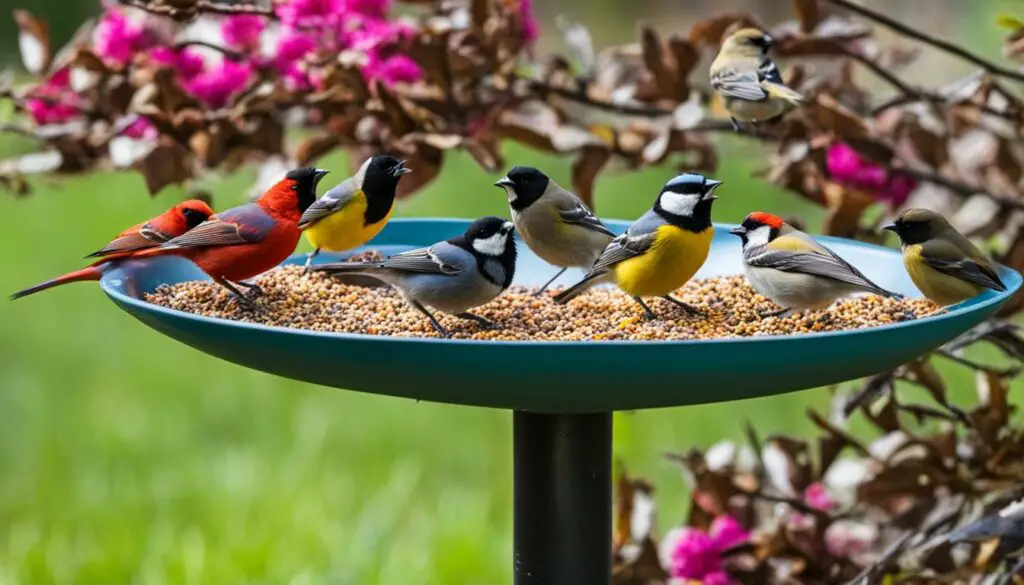
When it comes to bird seed preferences, consider the following:
- Black-oil sunflower seed is a popular choice for many feeder birds, including jays, woodpeckers, finches, and cardinals.
- Nyjer (thistle) seed is preferred by goldfinches, finches, and redpolls.
- Millet attracts ground-feeding birds like sparrows and juncos.
- Safflower seed is eaten by cardinals, grosbeaks, and sparrows.
By offering a mix of different seeds, you can attract a diverse range of bird species to your feeders. Remember to clean your feeders regularly and provide fresh seed and water to keep the birds coming back to your yard.
Bird Feeding Tips for Bird Watching Enthusiasts
When it comes to bird feeding, there are a few key tips that can enhance your birdwatching experience and attract a variety of bird species to your backyard. By following these simple guidelines, you can create a welcoming environment for birds and enjoy observing their fascinating behaviors up close.
Provide a Diverse Menu
Offering a variety of birdseed and food options is essential to attract different bird species. Consider providing a mix of seeds such as black oil sunflower seeds, millet, and cracked corn. Additionally, offering suet cakes or homemade bird-friendly recipes can entice woodpeckers, wrens, and other insect-loving birds. By diversifying your bird menu, you’ll increase the likelihood of attracting a wide range of feathered visitors.
Choose the Right Feeders
Using different types of feeders can cater to the feeding preferences of various bird species. Tube feeders are ideal for small feeder birds like chickadees and finches, while platform feeders attract ground-feeding birds such as sparrows and juncos. Providing hummingbird feeders with nectar solutions can attract these vibrant flyers. It’s important to regularly clean and refill feeders to ensure a fresh supply of food for the birds.
Create a Bird-Friendly Habitat
Enhancing your backyard with native plants, shrubs, and trees can create a natural habitat that birds will find appealing. These plants provide shelter, nesting opportunities, and natural food sources like berries and insects. Including a water source such as a birdbath or fountain is also crucial for attracting birds. The sound and sight of moving water can be particularly enticing for many bird species.
Protect Birds from Predators
Ensuring the safety of birds is paramount when engaging in bird feeding. Placing feeders away from potential hiding spots for predators, like bushes or trees, can help protect the birds. Additionally, keeping cats indoors and applying window decals to prevent collisions can safeguard bird populations in your area.
By following these bird feeding tips, you can create a bird-friendly environment that gives you the opportunity to witness the beauty and behaviors of numerous bird species. Birdwatching becomes even more enjoyable when you know you’re providing a valuable resource for our feathered friends.
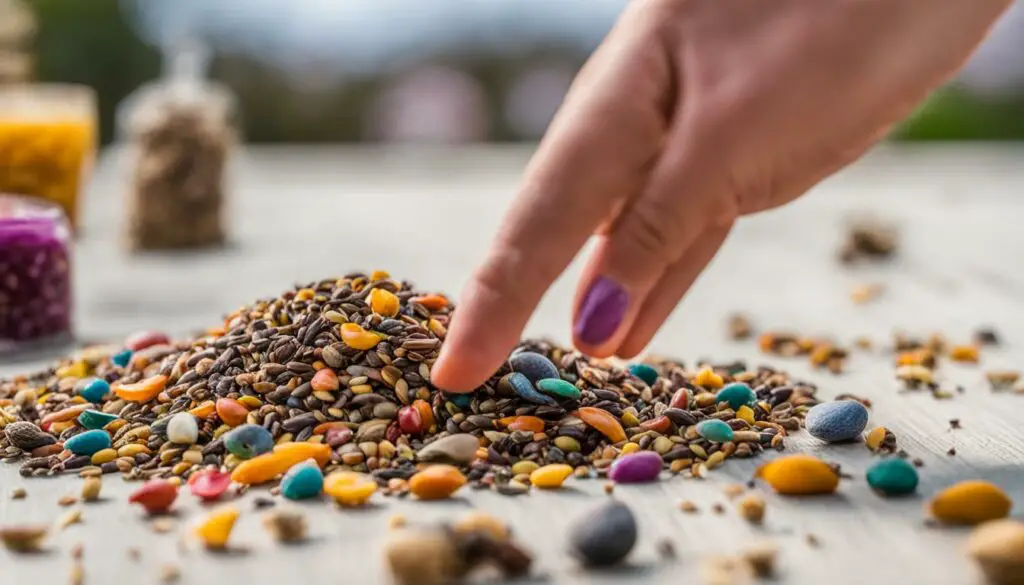
Making Your Yard Bird-Friendly
Creating a bird-friendly yard is essential to attract and support a wide variety of bird species. By providing a safe and inviting environment with ample food, water, and shelter, you can enhance the presence of birds in your yard and contribute to their well-being. Here are some key tips for making your yard bird-friendly:
1. Plant Native Plants
Native plants are not only beautiful but also provide natural food sources and cover for birds. Choose a variety of native trees, shrubs, and flowers that offer berries, seeds, and nectar throughout the year. Native plants attract insects, which are an important food source for many bird species. Additionally, native plants require less water and are better adapted to the local climate, making them more sustainable choices for your yard.
2. Provide Water Sources
Water is essential for birds, both for drinking and bathing. Adding a bird bath, fountain, or dripper to your yard will attract birds and provide them with a vital resource. Moving water is particularly attractive to birds, so consider adding a small fountain or a dripper to your bird bath. Ensure that the water source is clean and provide fresh water regularly. Regular cleaning helps prevent the spread of diseases and ensures that birds have access to clean drinking and bathing water.
3. Create Shelter
Offering shelter is crucial for birds to feel safe and secure in your yard. Planting trees and shrubs with dense foliage provides cover for birds to hide from predators, seek shelter from harsh weather, and find suitable nesting sites. Consider adding birdhouses or nesting boxes to your yard to provide additional nesting opportunities for cavity-nesting species. Providing a variety of shelter options will attract more bird species to your yard and create a diverse and vibrant bird community.
By implementing these bird-friendly practices, you can transform your yard into a haven for birds. Enjoy the beauty and wonder of these winged visitors as they make your yard their home.
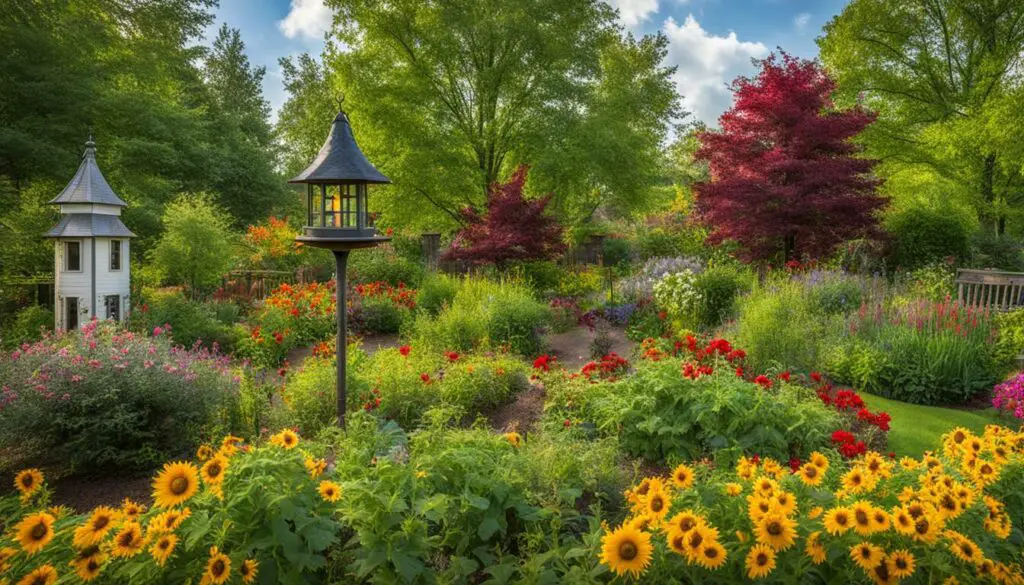
Table: Native Plants for Bird-Friendly Yards
| Plant | Seasonal Interest | Food Source | Cover |
|---|---|---|---|
| Eastern Red Cedar | Evergreen | Berries | Shelter |
| Serviceberry | Spring flowers, fall berries | Berries | Nesting |
| Black-eyed Susan | Summer flowers | Seeds | Nesting |
| Trumpet Vine | Summer flowers | Nectar | Nesting |
| Red Maple | Spring flowers, fall colors | Seeds | Shelter |
Source: Native Plants for Wildlife Habitat and Conservation Landscaping – U.S. Fish and Wildlife Service
Putting out the Right Meal
When it comes to bird feeding, putting out the right meal can make all the difference in attracting a diverse range of bird species to your feeders. Different types of bird seed are preferred by different birds, so it’s important to offer a variety of options. Black oil sunflower seeds, either in tube feeders or mixed with other seeds, are a favorite among many small feeder birds such as chickadees, finches, and cardinals. Nyjer (thistle) seed is a must-have for attracting finches and goldfinches, while suet cakes are a hit with woodpeckers and nuthatches.
To create a balanced bird buffet, consider offering a blend of seeds containing sunflower seeds, millet, and cracked corn. This mix will appeal to a wide range of bird species, from jays and sparrows to wrens and bluebirds. By providing a combination of different seed types, you’ll increase your chances of attracting a diverse array of feathered visitors.
Additionally, don’t underestimate the power of fresh water in attracting birds to your yard. Consider adding a bird bath or fountain to provide birds with a source of clean drinking and bathing water. Moving water, such as a dripping or cascading feature, can be particularly enticing to birds. Keep the water source clean and filled regularly to ensure birds have access to this vital resource.
| Bird Seed Type | Preferred Birds |
|---|---|
| Black oil sunflower seeds | Chickadees, finches, cardinals, jays, sparrows |
| Nyjer (thistle) seed | Finches, goldfinches, siskins |
| Suet cakes | Woodpeckers, nuthatches |
| Mixed blend (sunflower seeds, millet, cracked corn) | Jays, sparrows, wrens, bluebirds |
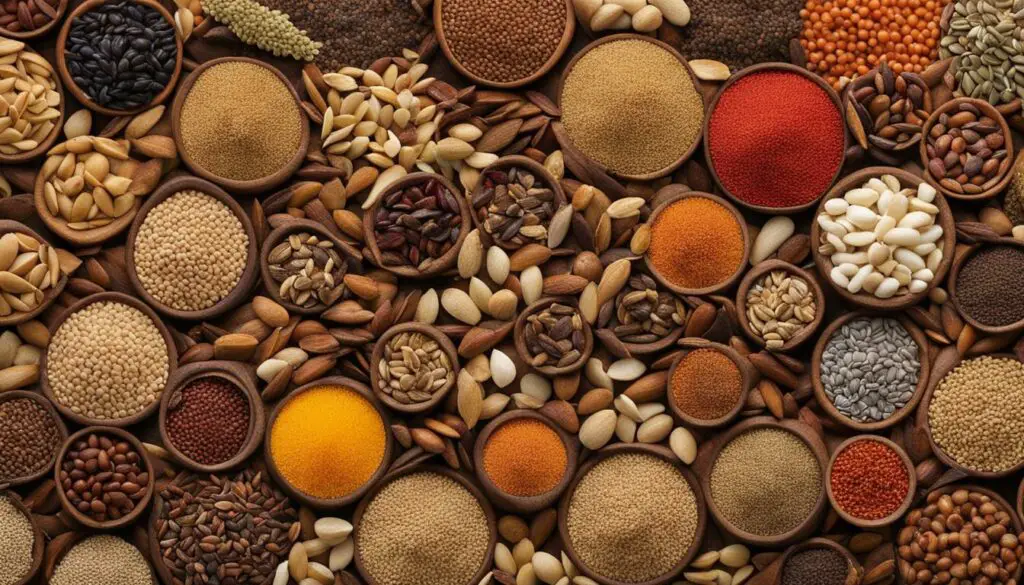
Don’t Forget the Water
When it comes to bird feeding, providing water is just as important as offering the right types of seed. Birds need water for drinking and bathing, and having a water source in your yard can attract even more feathered visitors. Consider adding a bird bath or a shallow dish of water to your bird-friendly space. Moving water, such as a birdbath with a fountain or dripper, can be particularly enticing to birds.
It’s crucial to keep the water source clean and fresh. Birds rely on clean water for their health and hygiene. Regularly cleaning the bird bath and replenishing the water will prevent the spread of diseases and ensure that birds have access to clean drinking and bathing water. Remember to clean the bird bath at least once a week, scrubbing it with a brush and rinsing thoroughly before refilling it with fresh water.
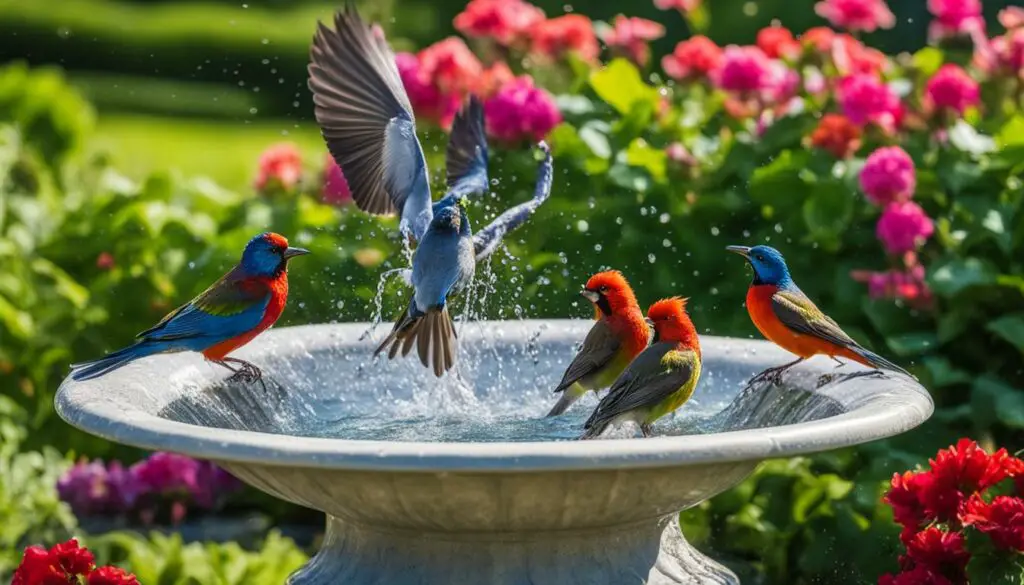
By providing a water source in your bird-friendly yard, you will enhance the appeal of your space to birds and create a vital resource for their well-being. Watching birds drink, bathe, and splash around in the water can also be a delightful and entertaining experience for bird enthusiasts of all ages.
Making Sure Your Feed is for Birds Only
When it comes to bird feeding, it’s important to ensure that your feeders are exclusively for birds. Unwanted animals like raccoons and squirrels can be a common nuisance, attempting to access the bird feeders and depleting the food meant for our feathered friends. To keep your feeders exclusive to birds, there are a few steps you can take.
First, consider the placement of your feeders. Opt for locations that are difficult for animals to reach, such as between two trees on a wire or in areas inaccessible to squirrels or other potential predators. Baffles and weight-activated feeders can also be effective deterrents, making it challenging for animals to access the bird feed. Regular cleaning of feeders and removal of food scraps at night can help discourage animal visitors and keep the feeders for birds only.
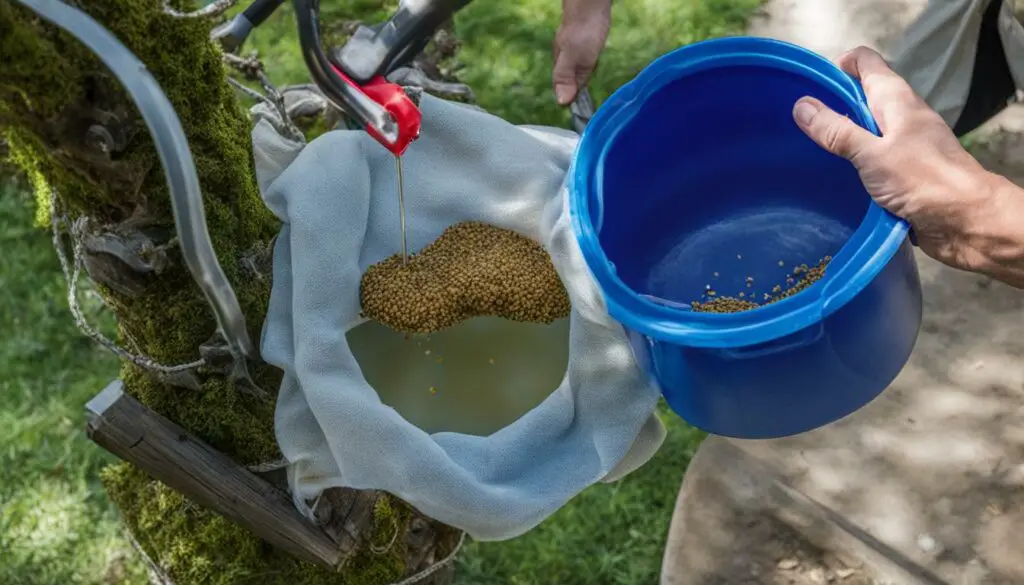
Table 1: Tips for making your bird feeders exclusive to birds
| Tip | Description |
|---|---|
| Choose strategic placement | Position feeders in areas that are difficult for animals to access, such as between two trees on a wire. |
| Use baffles and weight-activated feeders | Deter animals by utilizing baffles or weight-activated feeders that make it challenging for them to access the bird feed. |
| Regularly clean feeders | Keep feeders clean and remove food scraps at night to discourage animal visitors. |
By following these precautions, you can ensure that your bird feeders are reserved solely for the enjoyment and sustenance of birds. Not only will this help prevent unwanted animals from depleting the feed, but it will also create a safe and inviting space for our feathered friends to thrive.
Taking Care of Your Feeders
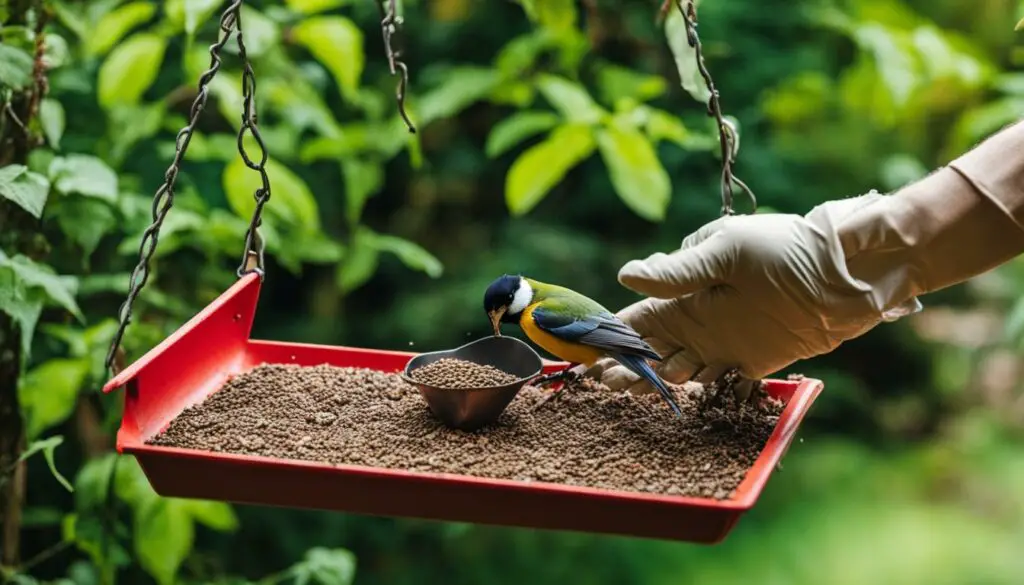 Whether you’re a seasoned bird feeder or a novice, it’s important to take proper care of your feeders to ensure the health and safety of the birds visiting your yard. Regular maintenance not only keeps the feeders clean and functional but also helps prevent the spread of diseases among the bird population. Here are some bird feeding tips to help you maintain your feeders effectively:
Whether you’re a seasoned bird feeder or a novice, it’s important to take proper care of your feeders to ensure the health and safety of the birds visiting your yard. Regular maintenance not only keeps the feeders clean and functional but also helps prevent the spread of diseases among the bird population. Here are some bird feeding tips to help you maintain your feeders effectively:
1. Clean and dry your feeders regularly: Empty and clean your feeders at least once a week using warm water and soap. This helps remove any leftover seed or debris that may harbor bacteria or mold. After washing, make sure to thoroughly dry the feeders before refilling them to prevent moisture buildup.
2. Check for clumped or moldy seed: Inspect the seed in your feeders regularly. If you notice clumps or signs of mold, discard the seed and clean the feeders immediately. Moldy seed can be harmful to birds and cause health issues, so it’s essential to keep the feeders stocked with fresh, high-quality seed.
3. Position feeders away from predators: Squirrels and other predators can easily access bird feeders if they are too close to trees, fences, or other structures. To deter these unwanted visitors, place the feeders in open areas or use baffles and weight-activated feeders to prevent access. This ensures that the birds have a safe space to feed without interference.
4. Provide a variety of feeders: Different bird species have different feeding habits and preferences. By offering a variety of feeder types, such as tube feeders, platform feeders, and suet feeders, you can attract a wider range of birds to your yard. This diversity creates a dynamic and exciting environment for both you and the birds.
By following these bird feeding tips and practicing regular maintenance, you can create a welcoming space for birds in your yard while ensuring their health and well-being. Happy bird feeding!
Placing and Maintaining Your Bird Feeder
When it comes to placing and maintaining your bird feeder, there are a few key factors to consider. First and foremost, it’s important to think about both your own viewing pleasure and the safety of the birds. Positioning your feeder at least 10 feet away from windows can help prevent bird collisions. Birds can mistakenly fly into windows, causing injury or even death. Keeping your feeder at a safe distance from windows reduces the chances of accidents occurring.
Another important consideration is the accessibility of your feeder to unwanted animals, such as squirrels or other predators. Placing your feeder in an area that is difficult for these animals to access can help protect the birds and their food. You can use baffles or weight-activated feeders to deter squirrels from reaching your feeder. These mechanisms make it more challenging for squirrels to get to the bird seed, ensuring that it remains reserved for the birds.
Regular maintenance is also crucial to ensure that your feeder remains clean and safe for the birds. Cleaning and refilling your feeder on a consistent basis provides a fresh supply of food and helps prevent the spread of diseases. Clumped or moldy seed should be removed, and the feeder should be cleaned and dried before refilling. By prioritizing the cleanliness and maintenance of your feeder, you can provide a hygienic and inviting space for birds to enjoy.
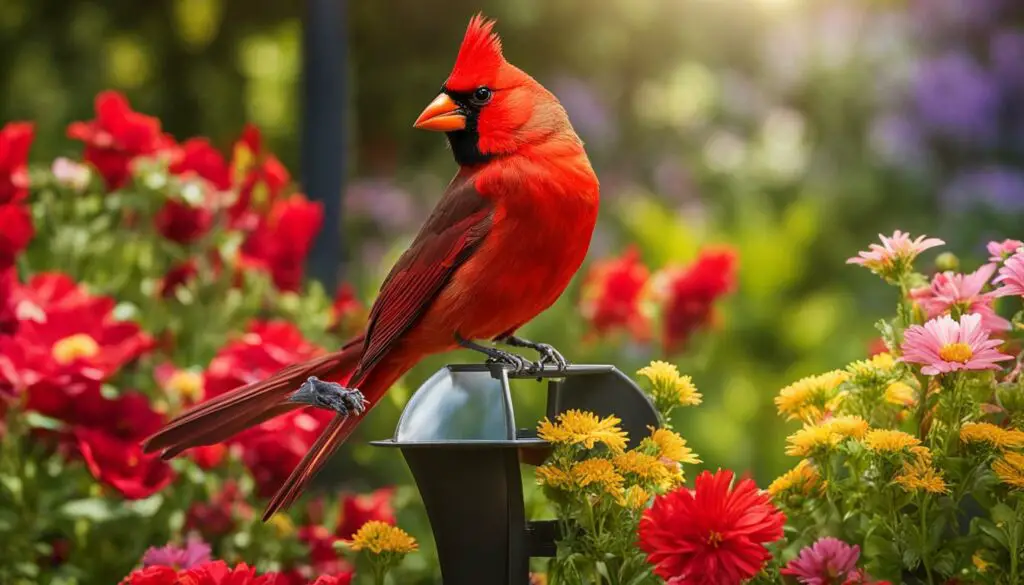
Summary
- Place your bird feeder at least 10 feet away from windows to prevent collisions.
- Avoid placing the feeder in areas accessible to squirrels or other predators.
- Use baffles or weight-activated feeders to deter squirrels.
- Regularly clean and refill your feeder to maintain a fresh supply of food and prevent the spread of diseases.
By thoughtfully placing and maintaining your bird feeder, you can create a safe and inviting space for birds while ensuring optimal viewing opportunities for yourself. Remember to prioritize the safety of the birds by placing the feeder away from windows and protecting it from unwanted animals. Regular maintenance will ensure that the birds have access to clean food and water, enhancing their overall well-being. Enjoy the beauty and wonder of your feathered visitors as they make your backyard their home!
Basics to Bird Feeding
Feeding birds is not only a delightful pastime but also an important way to support our feathered friends. By providing them with a reliable food source, we can help them thrive, especially during harsh weather conditions when natural food may be scarce. To get started with bird feeding, you’ll need a few essentials:
- A bird feeder: Choose a feeder that suits the types of birds you want to attract. There are various feeders available, including platform feeders, tube feeders, and suet feeders.
- Tree or shepherd’s hook: Find a sturdy location to hang your feeder, ensuring it’s easily accessible for birds but safe from potential predators like squirrels.
- Bird seed: Select the right seed for the birds you want to attract. Popular options include black-oil sunflower seed, millet, and Nyjer (thistle) seed.
- Bird identification guide: Keep a guide handy to identify the different bird species that visit your feeder. This will help you appreciate the diverse avian visitors to your yard.
Once you have these essentials in place, you can start attracting birds to your feeder. Remember to clean and refill your feeder regularly to ensure a fresh supply of food. Be patient, as it may take some time for birds to discover your feeding station.
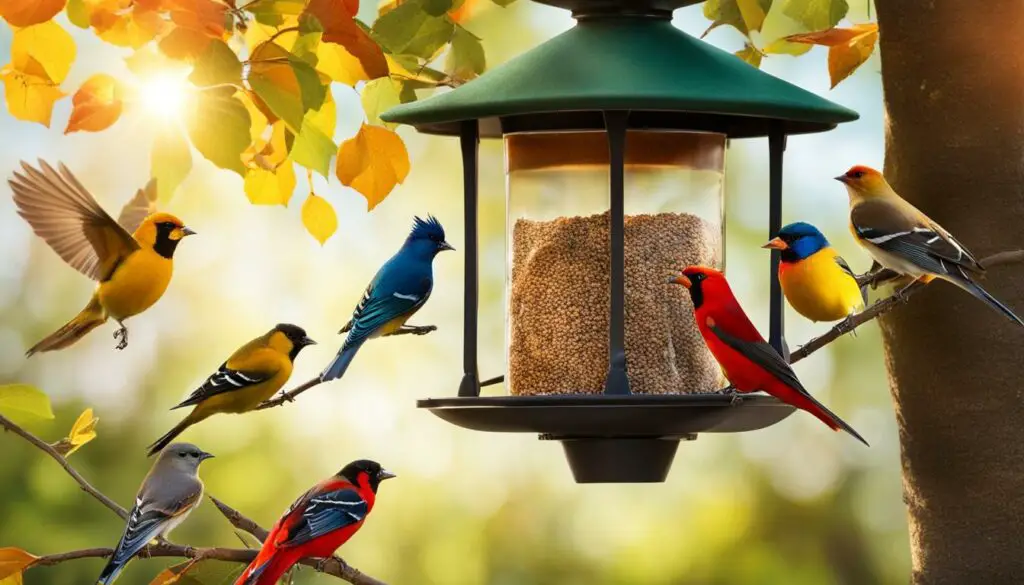
Some Dos and Don’ts for Bird Feeding
When it comes to bird feeding, there are certain dos and don’ts to keep in mind:
- Do offer a variety of seeds: Different birds have different dietary preferences, so offering a variety of seed types will attract a greater diversity of bird species to your feeder.
- Don’t use insecticides near your feeder: Insecticides can be harmful to birds, as they rely on insects as a food source. Avoid using them in the vicinity of your feeding station.
- Do keep your feeder clean: Regularly clean your feeder to remove mold, bacteria, and spoiled seed. This will help protect the health of visiting birds.
- Don’t use cracked or moldy seed: Birds are less likely to consume cracked or moldy seed, and it can also be harmful to their health. Discard any damaged seed and replace it with fresh seed.
- Do provide fresh water: Birds need a source of fresh water for drinking and bathing. Consider adding a bird bath or shallow dish of water near your feeding station.
- Don’t hang feeders too close to windows: To prevent bird-window collisions, make sure there is sufficient distance between your feeder and any nearby windows. Consider using window decals to further reduce the risk.
Table: Common Bird Seed Types and Preferred Birds
| Seed Type | Preferred Birds |
|---|---|
| Black-oil sunflower seed | Jays, woodpeckers, finches, cardinals |
| Millet | Sparrows, juncos |
| Nyjer (thistle) seed | Finches, redpolls, goldfinches |
By following these bird seed dos and don’ts, you can create a welcoming environment for a variety of bird species, ensuring their well-being and adding beauty to your backyard.
Conclusion
As I conclude this article on bird seed feeding guidelines, it is clear that attracting birds to your backyard is a rewarding and enjoyable experience. By following the essential guidelines provided in this article, you can create a space that appeals to a diverse range of bird species.
Offering a variety of seeds in separate feeders is key to attracting a greater variety of birds. Different bird species have specific preferences when it comes to seed types, so it is important to choose the right seed for the birds you hope to attract. Experimenting with different seed types and observing the preferences of different bird species can help you find the perfect combination.
In addition to providing the right seed, maintaining your bird feeders and offering fresh water sources are crucial. Regular cleaning and refilling of feeders ensure a hygienic and inviting environment, while water sources like bird baths or fountains provide essential hydration for birds. Creating a bird-friendly yard with native plants and adequate shelter further enhances the appeal of your backyard to birds.
Remember, attracting birds to your feeders may take time, so be patient and persistent. Keep experimenting with seed types and feeder placement until you find the perfect formula for attracting a vibrant mix of bird species. By following these bird seed feeding guidelines and providing a welcoming space for our feathered friends, you can enjoy the beauty and wonder of birdwatching right in your own backyard.
FAQ
What type of bird seed should I use to attract a variety of birds to my backyard?
Offering a variety of seeds in separate feeders will attract the greatest variety of birds. Popular types of birdseed include black-oil sunflower seed, Nyjer (thistle) seeds, peanuts, and a blend containing sunflower seeds, millet, and cracked corn.
What specific bird species are attracted to different types of bird seed?
Black-oil sunflower seed attracts jays, woodpeckers, finches, and cardinals. Millet is favored by sparrows and juncos, while cracked corn attracts various ground-feeding birds. Safflower seed is eaten by cardinals, grosbeaks, and sparrows, and Nyjer (thistle) seed is preferred by goldfinches, finches, and redpolls.
How can I attract woodpeckers, wrens, and other birds that enjoy suet?
Suet, which is beef fat mixed with seed, can be placed in special feeders or net onion bags. It appeals to woodpeckers, wrens, chickadees, nuthatches, and titmice.
How can I make homemade bird feeders to attract specific bird species?
You can create homemade bird feeders using peanut butter pudding or fruit for berry-eating birds. For example, mixing peanut butter with cornmeal and stuffing it into holes drilled in a hanging log or pine cone attracts woodpeckers, chickadees, titmice, and warblers.
How can I find out which bird species are present in my area?
Contact your state or local wildlife agency, join a bird club, or use bird identification apps like Merlin Bird ID and Audubon. The eBird app can also provide information on recent bird sightings in your area.
How can I create a bird-friendly yard?
Provide a safe environment with adequate food, water, and shelter. Plant native plants for natural cover and potential nesting sites, and include a water source like a bird bath. Ensure feeders and other bird-related structures are free from hazards and threats to birds.
What should I do to maintain my bird feeders?
Clean feeders regularly using warm water and soap, and remove clumped or moldy seed. Check and refill feeders as needed to ensure a constant supply of food for birds.
Where should I place my bird feeder to attract birds?
Position feeders at least 10 feet from windows to prevent bird collisions and in areas inaccessible to squirrels or other predators. Consider using baffles or weight-activated feeders to deter squirrel access.
What are the basics of bird feeding?
Bird feeding involves providing essential elements of food, water, and shelter. Choose the right variety of quality seed, offer different seed types to attract a wide range of bird species, and provide fresh water sources.
How can I ensure my feeders are reserved for birds only?
Take steps to deter unwanted animals like raccoons and squirrels, such as placing feeders in difficult-to-reach locations and regularly cleaning feeders and removing food scraps at night.
How should I take care of my feeders?
Regularly maintain and clean feeders to prevent the spread of diseases and ensure a hygienic and inviting space for birds to enjoy.
What are some important tips for bird feeder placement and maintenance?
Place feeders at different levels to accommodate the feeding habits of various bird species. Regularly clean and refill feeders, and keep them at least five feet above the ground to prevent animal access.
What are some bird feeding basics I should know?
Bird feeding is a way to supplement the natural diets of North American bird species. It provides benefits to birds by offering a reliable food source, especially during winter months when natural food supplies may be scarce.
Why is water important for attracting birds?
Adding a water source like a bird bath provides birds with a vital resource for drinking and bathing. Moving water, such as a birdbath with a fountain or dripper, can be particularly attractive to birds.
How can I ensure my bird feed is exclusive to birds only?
Take steps to deter unwanted animals like raccoons and squirrels, such as placing feeders in difficult-to-reach locations and regularly cleaning feeders and removing food scraps at night.
How should I take care of my bird feeders?
Regularly maintain and clean feeders to prevent the spread of diseases and ensure a hygienic and inviting space for birds to enjoy.

